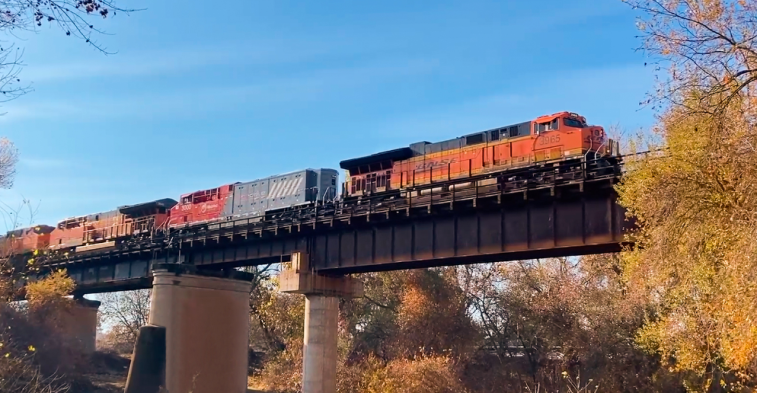7 STATES WITH COMPREHENSIVE FACILITIES FOR THE MULTIMODAL TRANSPORTATION OF GOODS
Thankfully, with COVID-19 vaccination programs in full swing, it appears that we are emerging out of the worst of the pandemic which has blighted the lives of so many people and caused so much devastation to businesses across all industries.
Major parts of the U.S. economy, quite literally, were brought to a standstill with enforced closures and restrictions on the movement of people.
However, despite the disruption caused by the coronavirus pandemic, goods were still shifted in enormous volume during the course of 2020, the value of such activity in the U.S. and Canada estimated to have surpassed $6.8 billion.
This figure should steadily rise given how increasingly dependent intermodal transport activity is on the consumer economy’s demand. It is also supported by well-developed hubs across all states that help to facilitate the movement of goods as seamlessly as possible.
Here, we take a look at just some of the U.S. states with the most favorable logistics infrastructure.
Illinois
The midwestern state is extremely well served by an array of transport hubs, the most significant being situated in and around its primary city of Chicago.
Staggeringly, around a quarter of all rail freight calls into the city either as a final destination or stop on a journey to another terminus. Meanwhile, O’Hare International Airport processes around 2 million metric tons of cargo at a value of approximately $200 billion every year.
The state is also indebted to what is North America’s largest inland port in the form of CenterPoint Intermodal Center. Situated in the Joilet and Elwood area, around 40 miles southwest of Chicago, it is a 6,400-acre master-planned intermodal development that sees 3 million TEUs pass through it every year. It is currently home to more than 30 tenant companies that, between them, occupy more than 14 million square feet of space.
CenterPoint Intermodal Center is also built with heavyweight roads able to withstand massive pressure and contains several other useful features such as water and utility systems, public bus service connections, no restrictions on trailer parking ratios and 24/7 on-site fire and police protection.
The site contains a massive 785-acre Union Pacific Railroad complex just south of Joliet, while another enormous rail complex measuring 770 acres that is operated by BNSF lies farther to the southwest.
When all of this is taken into consideration, CenterPoint can rightly be referred to as Illinois’ intermodal epicenter.
The state is also making waves in the port scene, with officials recently announcing a $110 million fund to modernize public ports across the territory. Illinois is home to a network of waterways that includes 19 public port districts and more than 400 private terminals along the Illinois, Kaskaskia, Ohio and Mississippi rivers.
Texas
The Lone Star State is also no stranger to port-based trade.
Texas has no fewer than 11 deep-draft ports, eight shallow-draft ports and two recreational ports that combine to make a critical contribution to the economic growth of the state, and represent key components of the region’s transportation system.
The southern state’s ports are backed up by some of the country’s largest interstate highways and an enormous network of railroads.
According to figures released by the Association of American Railroads, Texas received 208.1 million tons of rail freight in 2019, the most of any state. To put that in context, Illinois, the second-ranked state, received 107.4 million terminated rail tons. Texas also, unsurprisingly, has by far the largest network of rail infrastructure in terms of outright length, measuring at 10,460 miles compared to second-placed Illinois, which has 6,883 miles of track.
Over in Dallas, a fairly recent addition to the city’s intermodal transport infrastructure (opening in 2015) is the Wylie Intermodal Terminal. It is a $64 million development owned by Kansas City Southern Railway (KCS), and is set to capitalize on significant opportunities in cross-border activity with Mexico.
Wylie itself is a city and northeastern suburb of Dallas, with the KCS terminal sprawling across 500 acres of land and servicing 12 gulf ports and one Pacific Ocean port, as well as more than 140 transload centers and 11 intermodal ramps. KCS also provides 181 interchange points with other railroads, including all U.S. and Mexico Class 1 railroads.
Michigan
In a typical year, one without the disruptions caused by the pandemic, U.S. freight railroads move around 1.7 billion tons across nearly 140,000 miles of privately-owned infrastructure that run through 49 states.
Michigan is home to 28 such railroads and ranks 14th in terms of total rail miles, with 3,465 miles of track at its disposal. In 2019, it received 31.4 million tons of rail-based cargo and sent 21.2 million tons on its way to other parts of the country or abroad.
The Detroit region offers extensive logistics options for businesses, including world-leading warehousing and what is often cited as the nation’s best undergraduate and graduate supply chain and logistics university courses.
Furthermore, the region’s strategic location on the Canadian border grants prime access to the wider U.S. and Canadian markets, with more than 47 million people within just a five-hour drive.
Detroit also contains more than 2,000 miles of interstates and highways, four Class 1 railroads, seven cargo ports and 15 airports. In total, the region moves $44 billion of goods evert year.
According to the Michigan Freight Plan devised in 2017, the state has “an extensive transportation infrastructure system that supports more than $862 billion in economic activity on an annual basis, from ports to rail and highways to runways.”
California
Over on the West Coast, California boasts some of the most comprehensive logistics infrastructure in the country, especially when it comes to ports and railroads.
Indeed, California is the third most popular destination for rail freight in the United States, receiving 94.9 million tons in 2019 – the state is also fifth in terms of total tail miles, with 4,971 miles of track spanning over two Class 1 railroads and 26 short-line railroads.
Los Angeles is home to the West Coast’s busiest seafaring trade hub thanks to the adjoining ports of Los Angeles and Long Beach. In total, California has one private and 11 public deep seaports and numerous private port and terminal facilities. These handle more than 40% of the total containerized cargo entering the U.S., and almost a third of the nation’s exports.
Such formidable infrastructure is even further bolstered by 5,800 commercial miles of high traffic volume interstate and state highways, and 12 airports with major cargo facilities.
All of this combines to present California as one of America’s most extensive, complex and interconnected freight hubs, a system which, according to the Californian government, employs 5 million people.
Washington
In the Pacific Northwest, Washington boasts an extraordinary number of ports–some 75 that are found in 33 of the region’s 39 counties. These are supported by 465 miles of navigable waterways for barge traffic on the Columbia and Snake rivers.
For companies needing logistics infrastructure for accessing the Pacific sea lanes, Washington represents the prudent choice, with many of the 75 ports a day’s sail closer to Asian markets than any others on the West Coast.
Washington also has the second-largest concentration of distribution centers on the Left Coast, well supplied by 30 railroads (including the Union Pacific and BNSF) which, between them, account for 2,891 miles of track. This allows the state to rank seventh in the U.S. in terms of rail cargo received (65.8 million tons a year).
Washington’s roads network is also well developed, with 7,000 miles of state highways and more than 39,000 miles of country roads that help reach the most remote parts of the region. In terms of air transportation, Seattle-Tacoma International Airport is the state’s largest international airport and the ninth busiest in the country.
Much of this infrastructure has been subject to improvements and expansions as part of the $70 billion Connecting Washington program, a bill voted for in 2015 that supports several major projects on the state’s roads, railways, ferry terminals and more.
Pennsylvania
The Keystone State boasts of 61 railroads in operation, the most of any state in the country. These transport around 150 million tons of freight in and out of the region annually.
The railroads feed a host of other important logistics infrastructure hubs, which include international airports at Erie, Harrisburg, the Lehigh Valley, Philadelphia, Pittsburgh and Wilkes-Barre/Scranton. Along with nine other scheduled-service, domestic passenger airports, they move 560,000 tons of material every year.
Pennsylvania’s three major ports are also extremely successful, exploiting their strategic position between the northeast and Mid-Atlantic and providing deep water, inland and Great Lakes access for convenient international importing and exporting. Indeed, the state’s foreign trade zone program has levelled the playing field and boosts U.S. competitiveness by reducing operational costs for businesses.
Joining all the logistical dots are more than 120,000 miles of state and local highways which, along with airports and railroads, are part of the Act 89 transportation plan–a commitment to improve numerous transit passages and hubs to the tune of more than $60 billion.
Wyoming
Our final stop is landlocked Wyoming, nestled in the Mountain West subregion of the western United States.
Despite being home to just six railroads spanning 1,877 miles, it tops the charts on originated rail tons by a long way. In 2019, 273.2 million tons of goods were sent from the state, more than double that of Illinois in second (125.9 tons).
Wyoming’s location means it relies heavily on road transportation to move goods from points A to B and onwards to other parts of the country. Here, it is well catered for, with Wyoming motorists collectively traveling 10.2 billion miles annually and moving a large proportion of the $66 billion of commodities shipped to and from the state each year.
The design, construction and maintenance of transportation infrastructure supports around 13,000 full-time jobs across all sectors of the economy, including tourism, retail, agriculture and manufacturing.
Wyoming’s airports also play an important supporting role. There are nine in total, the most significant being Jackson Hole Airport, located in the spectacular Grand Teton National Park.





Leave a Reply